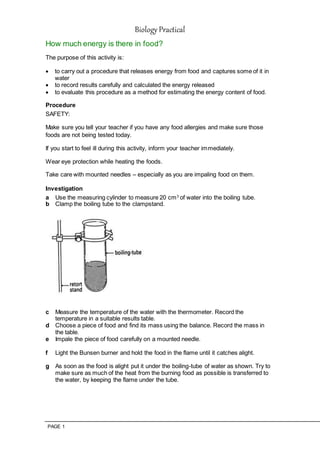
How much energy_is_there_in_food
- 1. Biology Practical PAGE 1 How much energy is there in food? The purpose of this activity is: to carry out a procedure that releases energy from food and captures some of it in water to record results carefully and calculated the energy released to evaluate this procedure as a method for estimating the energy content of food. Procedure SAFETY: Make sure you tell your teacher if you have any food allergies and make sure those foods are not being tested today. If you start to feel ill during this activity, inform your teacher immediately. Wear eye protection while heating the foods. Take care with mounted needles – especially as you are impaling food on them. Investigation a Use the measuring cylinder to measure 20 cm3 of water into the boiling tube. b Clamp the boiling tube to the clampstand. c Measure the temperature of the water with the thermometer. Record the temperature in a suitable results table. d Choose a piece of food and find its mass using the balance. Record the mass in the table. e Impale the piece of food carefully on a mounted needle. f Light the Bunsen burner and hold the food in the flame until it catches alight. g As soon as the food is alight put it under the boiling-tube of water as shown. Try to make sure as much of the heat from the burning food as possible is transferred to the water, by keeping the flame under the tube.
- 2. Biology Practical PAGE 2 h Hold the food in place until the food has burnt completely. If the flame goes out, but the food is not completely burnt, quickly light it again using the Bunsen burner and replace the food beneath the tube. i As soon as the food has burned away completely and the flame has gone out, measure the temperature of the water again. Before measuring, stir the water carefully with the thermometer and note down the highest temperature reached in the results table. j Repeat the procedure for other foods. k Calculate the rise in temperature each time. l Calculate the energy released from each food by using this formula. 4.2 is the value of the specific heat capacity of water, in joules per gram per degree Celsius – the number of joules taken to raise the temperature of water by 1ºC. 1 cm3 of water has a mass of 1 g. If the number is more than 1000 J/g, express it as kilojoules (kJ): 1 kilojoule = 1000 joules
- 3. Biology Practical PAGE 3 QUESTIONS 1 Compare your answers for the amount of energy in any food with the answers obtained by other groups in the class. What is the range of values measured by the class? Do any of the results look anomalous? What is the mean average value? 2 Compare your class’s answer for the energy in any food to the official value given for the food on its packet. Are your class results close to the official numbers? Are they higher or lower? If they are lower, you must be under-estimating the energy released from the food. 3 How could you improve your procedure or apparatus to overcome this? 4 This picture shows a piece of apparatus manufactured to measure the energy released from food. It is called a calorimeter. List as many things as you can see that make it an improvement to the apparatus used in your investigation. 5 Which foods give the most energy per gram? Are they most rich in fat, carbohydrate or protein? 6 What is the name of the process in living organisms that releases energy from food? 7 Write a word equation for this reaction. Is it the same as the reaction used in the investigation? Explain your answer. 8 What do living organisms do with the energy released from their food?
- 4. Biology Practical PAGE 4 ANSWERS 1 There is likely to be quite a big range of results. There may well be some anomalous results – much higher or much lower than other people’s. So there is scope for a lot of discussion about why there is such a wide range. 2 The mean average value for the class is likely to be quite different from the official value on the food packet, although the rank order of most energy to least should be similar. This method underestimates the energy released by a large amount because the water in the boiling tube does not catch much of the heat released. Also, the food may not be fully combusted. 3 Improvements to the apparatus should include catching more of the heat released by burning and also more accurate measures of temperature increase. 4 The calorimeter provides oxygen to encourage complete combustion, a jacket of water (often surrounding a copper vessel) to absorb most of the heat released, a heat transfer coil to capture the heat in the gases released by burning, a stirrer to mix the warm and cool water before measuring the temperature, a larger volume of water so that increasing the amount of heat released will result in a comparatively small change of temperature. Depending on the quantity of food burned, this is useful. For small quantities of food and small amounts of energy a smaller volume of water would give a more easily detectable result. © Nuffield Foundation 1996 5 Foods most rich in fat give the most energy per gram. Carbohydrates and proteins give similar amounts of energy per gram. 6 The process in living organisms that releases energy from food is called respiration. 7 carbohydrate + oxygen → carbon dioxide + water
- 5. Biology Practical PAGE 5 It is essentially the same reaction as that in the investigation. 8 Living organisms use the energy released from their food for making new body tissues (growth and repair) and for movement. Some is transferred to the surroundings as heat.
